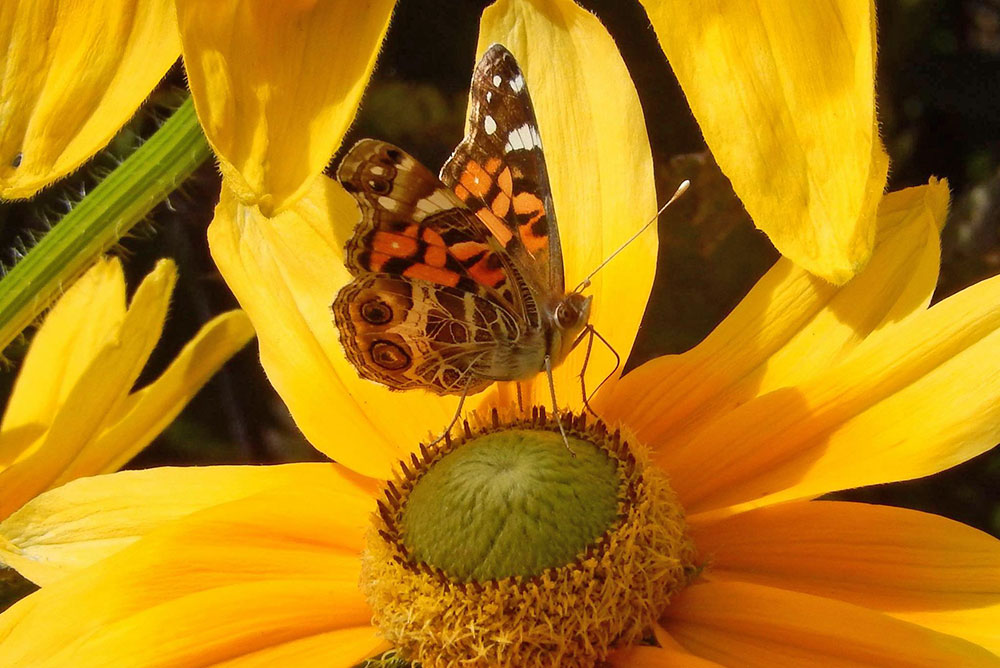
Maine Home Garden News August 2023
In This Issue:
- August Is the Month to . . .
- The Gardens at Tidewater Farm Are Growing!
- Pollinator Garden at Norway Memorial Library
- Late Blight Gardener Alert
- Cucumber Downy Mildew
- Maine Weather and Climate Overview (August)
- Featured Bird of the Month: Black-and-White Warbler
August Is the Month to . . .
By Barbara Harrity, Penobscot County Master Gardener Volunteer
“Summertime, and the living is easy…” as long as you keep up with the harvesting, processing, weeding, deadheading, and dividing…. Here’s our list of things to do in August:
- Visit your garden daily. Your vegetable garden changes rapidly this time of year, so visit it daily to keep up with the harvest and to catch problems before they become unmanageable. Harvesting crops at the optimal stage of development often increases yield because over-ripening fruits may trigger plants to slow production. Check out this resource to learn how best to store and wash fresh fruits and vegetables to maintain excellent flavor and quality until you eat them.
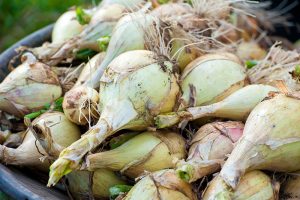 Harvest onions. Begin harvesting onions when half to three-quarters of the leaves have died back. Pull the onions in the morning and allow the bulbs to dry in the garden until late afternoon. Put the onions in a dry, protected, and shady location to prevent them from getting sunburned on hot, sunny days. Place bulbs under dry shelter on elevated slats or screens, or hang them in small bunches, before the evening dew falls. Complete drying and curing will take 2–3 weeks. After the bulbs dry, cut the tops 1.5 to 2 inches long, and place bulbs in cool, dry storage with good air circulation.
Harvest onions. Begin harvesting onions when half to three-quarters of the leaves have died back. Pull the onions in the morning and allow the bulbs to dry in the garden until late afternoon. Put the onions in a dry, protected, and shady location to prevent them from getting sunburned on hot, sunny days. Place bulbs under dry shelter on elevated slats or screens, or hang them in small bunches, before the evening dew falls. Complete drying and curing will take 2–3 weeks. After the bulbs dry, cut the tops 1.5 to 2 inches long, and place bulbs in cool, dry storage with good air circulation.- Harvest garlic and save some of the larger heads for replanting this fall. For more information about growing garlic, see UMaine Extension Bulletin #2063, Growing Garlic in Maine. August is also a good time to order seed garlic from a reputable source.
- Savor summer flavors for year-round enjoyment with safely preserved produce. UMaine food safety experts have compiled many excellent resources for the home gardener. Notable resources include refrigerator pickles, herbal vinegar, and over a dozen “how-to” videos. If you’re pressure canning, have your dial gauge checked annually for accuracy.
- Share your harvest. If you can’t keep up with all the produce from your garden, consider donating the excess to Maine Harvest for Hunger. Bulletin #4303, A Donor’s Guide to Vegetable Harvest will tell you when to harvest for the best quality.
- Sow cover crops: Cover crops are a great option for any garden with empty space. They can suppress weeds, benefit pollinators, and provide nutrients to the soil when incorporated as green manure. For more information about cover cropping, see UMaine Extension Bulletin #1170, Cover Cropping for Success, or watch these videos Benefits of Cover Cropping and Planning for Your Cover Crop, and consult these tables for seeding rates and times for different cover crops.
- Stay ahead of pests. The sooner pests are identified, the more successful your control measures applied will be. Please visit our Home and Garden IPM photo gallery or contact your county office if you’d like help with identification and information on how to manage plant pest insects and diseases.
- Enjoy the good bugs! Over 97 percent of insects usually seen in the home landscape are either beneficial or are “innocent bystanders” — not pests. See Bulletin #7150 Beneficial Insects and Spiders in Your Maine Backyard is a great way to minimize pest problems, often greatly reducing or eliminating pesticides.
- Practice low-input lawn care methods. For more information see Bulletin #2166 Steps to a Low-Input, Healthy Garden. Keep mower blades set high and leave clippings behind. Apply beneficial nematodes (PDF) in late August (timing is important) to keep white grubs in check and reseed bare spots to reduce weed pressure. This is also a good time of year to establish new lawns from seed.
- Irrigate. August can be one of the driest months of the year. Keep your soil moist without over-watering or wasting water with Bulletin #2160, Trickle Irrigation: Using and Conserving Water in the Home Garden.
- Rejuvenate strawberry beds and prune raspberry canes. For more information, see UMaine Extension Bulletin #2067, Growing Strawberries, and Bulletin #2066, Growing Raspberries and Blackberries.
- Dry flowers. August is a good time for collecting flowers, foliage, and seed heads for floral arrangements. A simple method is to wrap a bundle of stems together using rubber bands and suspend the bunch upside down. Warm, well-circulating air will dry the cut flowers quickly. See Drying Flowers and Foliage for Arrangements from the University of Missouri Extension or this group of articles from Cornell Cooperative Extension for more information.
-
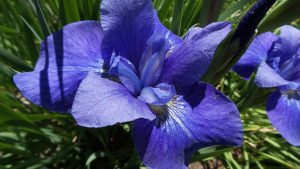
Siberian iris. Photo by C. Eves-Thomas. Divide daylilies and irises. Divide daylilies as they complete their bloom cycle and divide bearded irises three to four weeks after they bloom.
- Take cuttings of basil, coleus, and geranium. Many plants we consider annuals can make good winter companions when brought indoors. There’s no need to dig up the whole plant; simply follow the instructions, How to Propagate Annuals from Cuttings from Iowa State University.
- Attend Maine’s Agricultural Fairs! August is peak fair season in Maine. Check out the Maine Department of Agriculture, Conservation & Forestry’s full schedule of Agricultural State Fairs. Here are the fair dates for August 2023:
- Aug 3–6 Bangor State Fair
- Aug 3–6 Northern Maine Fair (Presque Isle)
- Aug 8–13 Topsham Fair
- Aug 10–19 Skowhegan State Fair
- Aug 24–27 Acton Fair
- Aug 24–27 Piscataquis Valley Fair (Dover-Foxcroft)
- Aug 26–27 Washington County Fair (Pembroke)
- Aug 27–Sept 4 Windsor Fair
- Aug 31–Sept 4 Blue Hill Fair
The Gardens at Tidewater Farm Are Growing!
By Abi Griffith, Tidewater Farm Coordinator, and Pamela Hargest, Horticulture Professional
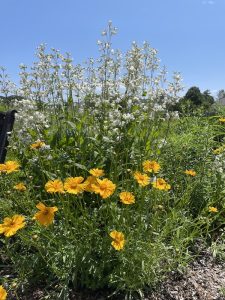 Since 2012, the Gardens at Tidewater Farm have provided agricultural and horticultural educational opportunities to the community, using research-based, environmentally friendly, and sustainable gardening practices. Established by UMaine Extension staff and Master Gardener Volunteers, the university currently leases 3 acres (located on the unceded territory of the Wabanaki people) from the town of Falmouth, with one-third of an acre under cultivation.
Since 2012, the Gardens at Tidewater Farm have provided agricultural and horticultural educational opportunities to the community, using research-based, environmentally friendly, and sustainable gardening practices. Established by UMaine Extension staff and Master Gardener Volunteers, the university currently leases 3 acres (located on the unceded territory of the Wabanaki people) from the town of Falmouth, with one-third of an acre under cultivation.
The original gardens consist of beautiful and meandering sections that run into each other and demonstrate a variety of designs, techniques, and native plantings. There’s a cottage garden, a rain garden, an herb garden, a children’s garden, a hidden garden under renovation, and a demonstration garden for displaying All-American Selection varieties. Additionally, there is a Harvest for Hunger garden, where vegetables are grown to be donated to local food pantries and food programs.
During the summer of 2021, Master Gardener Volunteers helped build permanent beds in the Harvest for the Hunger garden, using silage tarps and a method called double digging, which involves raising the height of the garden beds to improve drainage. With this newly added space for growing additional crops and flowers, 1,500 pounds of food was donated in 2022.
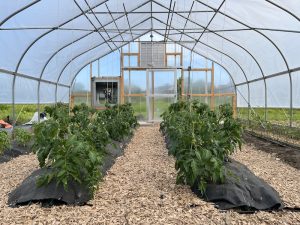 To build off of this achievement, we are finishing some major infrastructure projects that will increase our capacity to accommodate more hands-on learning and to support food security initiatives in the area! A high tunnel was installed with the help of volunteers this spring. Half the tunnel will be used to grow crops in a controlled environment for season extension, while the other half will be used for classes and starting seedlings early in the season. We are already seeing the benefits, as the tomatoes are thriving with the warmth and cover the high tunnel provides. With the addition of electricity, we are also thrilled to be installing a walk-in cooler to store produce harvested for donation. We also hope to provide space and refrigeration to local gleaning groups to maintain the shelf life and increase the amount of fresh produce to be donated.
To build off of this achievement, we are finishing some major infrastructure projects that will increase our capacity to accommodate more hands-on learning and to support food security initiatives in the area! A high tunnel was installed with the help of volunteers this spring. Half the tunnel will be used to grow crops in a controlled environment for season extension, while the other half will be used for classes and starting seedlings early in the season. We are already seeing the benefits, as the tomatoes are thriving with the warmth and cover the high tunnel provides. With the addition of electricity, we are also thrilled to be installing a walk-in cooler to store produce harvested for donation. We also hope to provide space and refrigeration to local gleaning groups to maintain the shelf life and increase the amount of fresh produce to be donated.
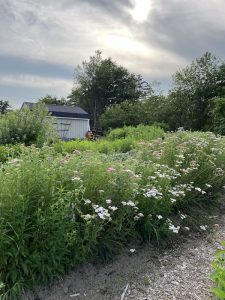 We are fortunate to have two apprentices at Tidewater this season, learning and giving their energy and hard work to help maintain and run the gardens. They are part of the inaugural class from UMaine Extension’s new Maine Horticulture Apprenticeship Training Program.
We are fortunate to have two apprentices at Tidewater this season, learning and giving their energy and hard work to help maintain and run the gardens. They are part of the inaugural class from UMaine Extension’s new Maine Horticulture Apprenticeship Training Program.
This season, Tidewater is continuing to host monthly field days on the second Saturday of the month through October, rain or shine. They are open to the public, family-friendly, and include hands-on demonstrations with UMaine Extension staff and Master Gardener Volunteers. Visit our upcoming events page for more information about upcoming field days and demonstration topics.
We hope you find time to discover why many people have a fondness and attachment to this community-built space!
Pollinator Garden at Norway Memorial Library
Article and photos by Phoebe Call, Oxford County Master Gardener Volunteer 2014; garden landscape plan by Steven Florenz
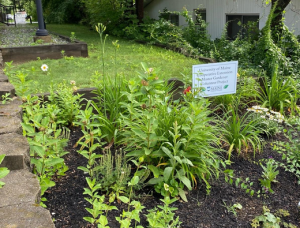 The Friends of Norway Memorial Library Master Gardener Volunteer (MGV) project kicked off in April 2022. The goal of the project is to add native plants and welcome pollinators to the landscaped areas surrounding the library and to create materials to educate the public about the benefits of native species and pollinators. The project team includes MGVs, Friends of the Norway Memorial Library board members, and the library director. Year 1 focused on removing weeds from the overgrown planted areas, adding some native plants to open areas, and cutting back the jungle of invasives – burning bush, bittersweet, autumn olive, and more.
The Friends of Norway Memorial Library Master Gardener Volunteer (MGV) project kicked off in April 2022. The goal of the project is to add native plants and welcome pollinators to the landscaped areas surrounding the library and to create materials to educate the public about the benefits of native species and pollinators. The project team includes MGVs, Friends of the Norway Memorial Library board members, and the library director. Year 1 focused on removing weeds from the overgrown planted areas, adding some native plants to open areas, and cutting back the jungle of invasives – burning bush, bittersweet, autumn olive, and more.
Rebecca Long from the Oxford County Extension Office put us in touch with a local native plant expert who helped us identify many of the plants around the library property. The good news, some natives are present; the bad news, lots of invasives are also present. One pleasant surprise was the prolific number of milkweed plants that have self-seeded around the property.
Transforming a weedy, stone-filled border along the back entrance to the library was one of our first tasks. We removed the landscape stone and the landscape fabric beneath, added soil, planted creeping juniper as a ground cover, and mulched the border for weed control. We selected creeping juniper for its spreading growth, drought tolerance, deer resistance, and availability. Lesson learned: do not use landscape fabric in your gardens*! The weeds grew through it making removal of the stone and fabric more difficult.
The Friends of the Library purchased materials for the project: soil, bark mulch, and five creeping juniper plants. Year 1 concluded with a much-improved border along the back walkway to the library, fewer invasives, and the addition of some new, donated natives with plans to start more from seed in spring 2023.
Several of the project team members participated in an early spring 2023 “starting natives from seed” workshop led by Rebecca Long at the Oxford County Extension Office. We hope to have some native plant seedlings ready to add to the library gardens in the future.
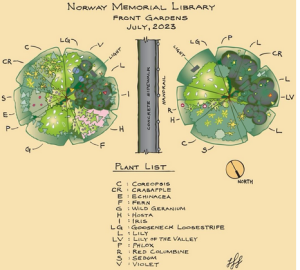
In 2023 the project gained a new MGV member with experience in drafting. We now have a great working landscape plan of the circular beds at the front of the library. The plan can be amended and expanded to include other garden areas as our work continues.
Conditions in spring 2023 were improved over 2022 given the addition of bark mulch and weed removal last year. Unfortunately, one of the crabapple trees at the front of the library was severely defoliated by browntail moth caterpillars. Weeding that bed was curtailed to avoid exposure after one of the group got the tell-tale rash from the caterpillar hairs. Two new areas at the back of the library were planted with sunflower and Tithonia seeds to add color for the summer. Tithonia, or Mexican sunflower, is a tall plant with flowers that are attractive to a wide variety of bees, butterflies, and hummingbirds.
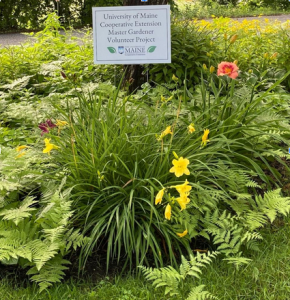
At a July planning meeting, the group agreed to focus on native plants, pollinators and educational aspects of the project. A picture-friendly treasure hunt activity for kids and school groups is being developed. This may include plant flashcards as the “hunt” participants find the pollinators and native plants around the garden. Each garden area will be named for a popular children’s book character. For adults, we plan to compile information about each plant, what pollinators different plants attract, the benefits of the pollinators, and their impacts on life cycles in nature.
The team looks forward to implementing the educational aspects of the project while continuing to expand the variety of natives and pollinators in the garden areas surrounding the library.
*For further information about the woes of using landscape fabric visit The disadvantages of landscape fabric from Illinois Extension.
Late Blight Gardener Alert
For more information please visit: Late Blight Gardener Alert
Cucumber Downy Mildew
By Ruby Bonilla, UMaine undergraduate student, Lab Technician IV, and Dr. Alicyn Smart, Director, Northeast Plant Diagnostic Network Plant Pathologist & Director of the University of Maine Cooperative Extension Plant Disease Diagnostic Laboratory
What is it and why is it a concern?
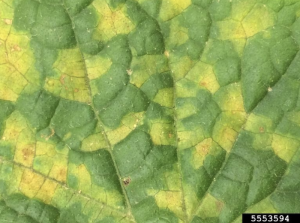
Cucumber downy mildew, commonly abbreviated as CDM, is a type of water mold that causes devastating outbreaks of disease in a very wide range of host plants. CDM is a significant concern to many farmers and gardeners because it can cause substantial crop losses without a proper management plan or strategy in place. CDM is caused by Pseudoperonospora cubensis which can affect many hosts, including cucurbits such as cantaloupe, cucumber, watermelon, squash, and pumpkin. Pseudoperonospora cubensis has two isolates that infect cucurbits which are referred to as clade 1 and clade 2. Clade 1 P.cubensis more frequently infects watermelon, pumpkin, and squash whereas clade 2 primarily infects cucumber and cantaloupe. So for instance say you observe CDM on your watermelon patch, it is not likely then that the pathogen will spread to your cucumbers. Additionally, isolates belonging to clade 2 have been reported to quickly become resistant to many fungicides, thus, fewer effective fungicides are available for downy mildew control in cucumber and cantaloupe varieties.
How can gardeners help?

Downy mildew is remarkably good at spreading under the right environmental conditions. The pathogen favors high humidity and rainfall, which allows it to produce thousands of sporangia (gray spores found on the undersides of infected leaves) which can then disperse in wind currents and be transported hundreds of miles. Gardners can help slow the spread of CDM by proactively scouting for the disease and managing crops once they are infected. Planting resistant cultivars of cucurbits and growing in areas with good drainage and maximum air circulation are great preemptive measures. Resistant cultivars to CDM include Citadel (pickling cucumber), Bristol (slicing cucumber), and Sun Jewel (specialty melon). Proper spacing of plants is also very important, for example zucchinis should be spaced 18-24 inches in rows 6 ft apart from each other and for cucumbers 26-60 inches apart. Applying fungicides can help slow the spread of downy mildew on infected plants. Types of fungicides and how they can be used for CDM can be found on the New England Vegetable Management Guide. Another great resource for managing CDM outbreaks is the “The Cucurbit Downy Mildew Forecast”. This is a great tool for tracking where outbreaks of CDM have occurred and where the pathogen is spreading. CDM overwinters as far south as Florida and slowly makes its way up North as the weather conditions become favorable. More information on this website can be found here: CDM Forecast.
What should they look for?
Symptoms of CDM can be easily recognizable in the garden. The main characteristic of the disease is the mosaic pattern of chlorosis and necrosis (dead cells) on the upper surfaces of cucurbit leaves. “Downy” comes from the fuzzy appearance of lesions located on the undersides of leaves. It’s important to note that the chlorotic and necrotic lesions on the leaves mostly occur within the veins of the leaves, creating a boxy-like appearance. Powdery mildew (shown in image 3) is white and grows over the veins of the leaves whereas downy mildew is dark brown-black in color and is restricted within the veins of the leaves. Other symptoms of infection include defoliation, wilting, and poor plant health.
What should someone do if they suspect they have it in their garden?
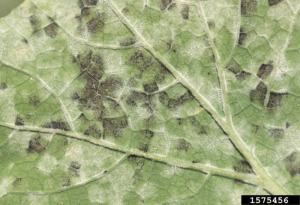
If you suspect your garden or crops are infected with downy mildew, it is important to act fast. Pull any diseased plants out of the garden and move them far away from healthy ones. If fungicides are on hand, they should be applied immediately at the onset of disease. Diseased plant material can be composted since CDM does not overwinter in Maine. Additionally, take photos of any diseased crops you might suspect to have cucumber downy mildew and send them to your local extension specialist. Physical plant samples can also be sent to your local diagnostic lab for testing and confirmation of pathogens affecting your crops or garden.
Sources:
- Disease Control – Downy Mildew. New England Vegetable Guide. (2023, January 6).
- McGrath, M. T. (2022, June). Managing Cucurbit Downy Mildew. Cornell Vegetables.
- McGrath, M. T. (N.D).Downy Mildew on Cucurbits: Early Symptoms. Cornell Vegetable MD Online.
- Quesada-Ocampo, L. (2018, December 16). Cucurbit downy mildew: NC State Extension Publications. Cucurbit Downy Mildew | NC State Extension Publications.
- Sudermann, M. (n.d.). Downy Mildew. Cornell Vegetables.
Maine Weather and Climate Overview (August)
By Sean Birkel, Assistant Extension Professor, Maine State Climatologist, Climate Change Institute, University of Maine Cooperative Extension. For questions about climate and weather, please contact the Maine Climate Office.
Since late May, large-scale weather patterns have repeatedly carried storm systems with abundant rainfall into our region. Statewide precipitation data from NOAA places June 2023 as the wettest since 2012, and the fifth wettest (tied with 1977 and 1998) in all for a record period beginning 1895. July 2023 has also been wetter than normal across most of the state, particularly in southern and western areas where station data in late July show month-to-date precipitation totals around the 85th percentile. July precipitation across Aroostook County has been near normal. Streamflow, groundwater, and soil moisture indicators likewise show normal, above, or much above normal statewide. This year’s wet conditions stand in sharp contrast to recent summers where parts of Maine experienced drought. Having too much water has caused waterlogging, plant rot, fast weed growth, and other difficulties for home gardeners and growers.

Since late June, large-scale circulation has persistently brought moist airflow from the south. This humidity has, in turn, caused overnight low temperatures to generally stay in the 60s. Observations from the Portland International Jetport show a record number of consecutive days (29 as of July 26) with the low temperature being 60 or above. This occurs on the backdrop of record high ocean surface temperatures across the North Atlantic since early March and record high global mean air temperatures in early July.
The NWS Climate Prediction Center 8–14 day outlook probability maps for August 2–8 (issued July 25) show below normal temperature and above normal precipitation for Maine. The 1-month outlook for August (issued July 20) shows above-normal temperature and an equal chance of above or below-normal precipitation. Looking further out, the three-month outlook for August–October (issued July 20) also shows above normal temperature and an equal chance of above or below-normal precipitation. These and other maps are available on the Maine Climate Office website. As always, be sure to check weather.gov for the latest weather forecast for your area.

Featured Bird of the Month: Black-and-White Warbler
By Andy Kapinos, Maine Audubon Field Naturalist
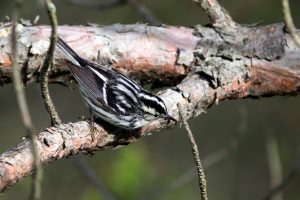
Some warblers are poorly named, but the Black-and-white Warbler is not one of them. These warblers are black-and-white-striped in every plumage, which is one way to distinguish them from other warblers. They are the only North American warbler that regularly searches for food in bark, creeping along tree trunks and large limbs, much like a nuthatch. Like many warblers, they are often heard before they are seen: their distinctive song consists of high-pitched, two-syllable phrases repeated several times (weesa weesa weesa weesa weesa) and sounds like a squeaky wagon wheel. They migrate to Maine to breed in deciduous or mixed forests with plenty of large trees for foraging and can be seen searching for insects in the bark of large oak, maple, and pine trees. If you have large trees in or around your backyard, keep an eye out for these unique warblers in the next couple of months as they begin their long journey back to wintering grounds in the Caribbean and Central America.
For more on the importance of planting Maine native plants to support birds like the Black-and-white Warbler and other wildlife, visit Maine Audubon’s “Bringing Nature Home” webpage.
Do you appreciate the work we are doing?
Consider making a contribution to the Maine Master Gardener Development Fund. Your dollars will support and expand Master Gardener Volunteer community outreach across Maine.
Your feedback is important to us!
We appreciate your feedback and ideas for future Maine Home Garden News topics. We look forward to sharing new information and inspiration in future issues.
Subscribe to Maine Home Garden News
Let us know if you would like to be notified when new issues are posted. To receive e-mail notifications, click on the Subscribe button below.
University of Maine Cooperative Extension’s Maine Home Garden News is designed to equip home gardeners with practical, timely information.
For more information or questions, contact Kate Garland at katherine.garland@maine.edu or 1.800.287.1485 (in Maine).
Visit our Archives to see past issues.
Maine Home Garden News was created in response to a continued increase in requests for information on gardening and includes timely and seasonal tips, as well as research-based articles on all aspects of gardening. Articles are written by UMaine Extension specialists, educators, and horticulture professionals, as well as Master Gardener Volunteers from around Maine. The following staff and volunteer team take great care editing content, designing the web and email platforms, maintaining email lists, and getting hard copies mailed to those who don’t have access to the internet: Abby Zelz*, Annika Schmidt*, Barbara Harrity*, Kate Garland, Mary Michaud, Michelle Snowden, Naomi Jacobs*, Phoebe Call*, and Wendy Roberston.
*Master Gardener Volunteers
Information in this publication is provided purely for educational purposes. No responsibility is assumed for any problems associated with the use of products or services mentioned. No endorsement of products or companies is intended, nor is criticism of unnamed products or companies implied.
© 2023
Call 800.287.0274 (in Maine), or 207.581.3188, for information on publications and program offerings from University of Maine Cooperative Extension, or visit extension.umaine.edu.
In complying with the letter and spirit of applicable laws and pursuing its own goals of diversity, the University of Maine System does not discriminate on the grounds of race, color, religion, sex, sexual orientation, transgender status, gender, gender identity or expression, ethnicity, national origin, citizenship status, familial status, ancestry, age, disability physical or mental, genetic information, or veterans or military status in employment, education, and all other programs and activities. The University provides reasonable accommodations to qualified individuals with disabilities upon request. The following person has been designated to handle inquiries regarding non-discrimination policies: Director of Equal Opportunity, 101 Boudreau Hall, University of Maine, Orono, ME 04469-5754, 207.581.1226, TTY 711 (Maine Relay System).
